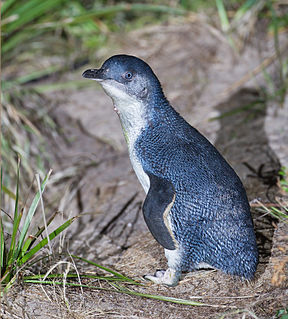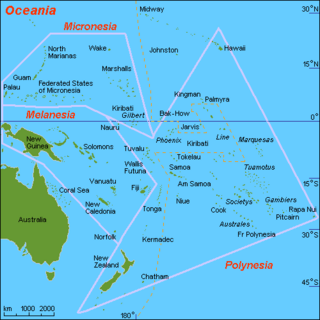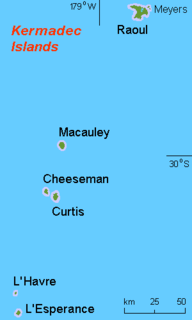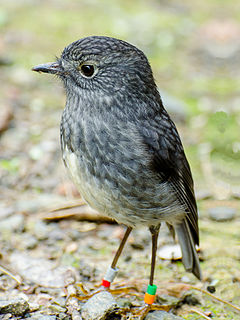
The little penguin is the smallest species of penguin. It grows to an average of 33 cm (13 in) in height and 43 cm (17 in) in length, though specific measurements vary by subspecies. It is found on the coastlines of southern Australia and New Zealand, with possible records from Chile. In Australia, they are often called fairy penguins because of their small size. In New Zealand, they are more commonly known as little blue penguins or blue penguins owing to their slate-blue plumage; they are also known by their Māori name: kororā.

Moa were nine species of now-extinct flightless birds endemic to New Zealand. The two largest species, Dinornis robustus and Dinornis novaezelandiae, reached about 3.6 m (12 ft) in height with neck outstretched, and weighed about 230 kg (510 lb). It is estimated that, when Polynesians settled New Zealand circa 1280, the moa population was about 58,000.

The Tasman Sea is a marginal sea of the South Pacific Ocean, situated between Australia and New Zealand. It measures about 2,000 kilometres (1,200 mi) across and about 2,800 kilometres (1,700 mi) from north to south. The sea was named after the Dutch explorer Abel Janszoon Tasman, who was the first recorded European to encounter New Zealand and Tasmania. The British explorer Captain James Cook later extensively navigated the Tasman Sea in the 1770s as part of his first voyage of exploration.

The Haast's eagle is an extinct species of eagle that once lived in the South Island of New Zealand, commonly accepted to be the Pouakai of Maori legend. The species was the largest eagle known to have existed. Its massive size is explained as an evolutionary response to the size of its prey, the flightless moa, the largest of which could weigh 230 kg (510 lb). Haast's eagle became extinct around 1400, after the moa were hunted to extinction by the first Māori.

The Chatham Islands form an archipelago in the Pacific Ocean about 800 kilometres (500 mi) east of the South Island of New Zealand. It consists of about ten islands within a 40-kilometre (25 mi) radius, the largest of which are Chatham Island and Pitt Island. Some of these islands, once cleared for farming, are now preserved as nature reserves to conserve some of the unique flora and fauna. The resident population is 600. The local economy is largely dependent on conservation, tourism, farming, and fishing.

The Oceanian realm is one of the World Wildlife Fund (WWF) biogeographic realms, and is unique in not including any continental land mass. It is the smallest in land of an area of the WWF realms.

The white-faced storm petrel, also known as white-faced petrel is a small seabird of the austral storm petrel family Oceanitidae. It is the only member of the monotypic genus Pelagodroma.

The yellow-eyed penguin or hoiho is a penguin native to New Zealand. Previously thought closely related to the little penguin, molecular research has shown it more closely related to penguins of the genus Eudyptes. Like most other penguins, it is mainly piscivorous.

The Kermadec Islands are a subtropical island arc in the South Pacific Ocean 800–1,000 km (500–620 mi) northeast of New Zealand's North Island, and a similar distance southwest of Tonga. The islands are part of New Zealand, 33 km2 (12.7 sq mi) in total area and uninhabited, except for the permanently manned Raoul Island Station, the northernmost outpost of New Zealand.

The New Zealand sea lion, also known as Hooker's sea lion, and whakahao in Māori, is a species of sea lion that primarily breeds on New Zealand's subantarctic Auckland and Campbell islands and to some extent around the coast of New Zealand's South and Stewart islands. The New Zealand sea lion numbers around 10,000 and is perhaps the world's rarest sea lion species. They are the only species of the genus Phocarctos.

Arctocephalus forsteri, the Australasian fur seal, South Australian fur seal, New Zealand fur seal, Antipodean fur seal, or long-nosed fur seal, is a species of fur seal found mainly around southern Australia and New Zealand. The name New Zealand fur seal is used by English speakers in New Zealand; kekeno is used in the Māori language. As of 2014, the common name long-nosed fur seal has been proposed for the population of seals inhabiting Australia.

Stephens Island is at the northernmost tip of the Marlborough Sounds in the South Island of New Zealand. It lies two kilometres to the northeast of Cape Stephens, the northernmost point of D'Urville Island. The island is 1.5 square kilometres in size, and rises 283 metres (928 ft) high from the sea.

The Chatham Rise is an area of ocean floor to the east of New Zealand, forming part of the Zealandia continent. It stretches for some 1,000 kilometres (620 mi) from near the South Island in the west, to the Chatham Islands in the east. It is New Zealand's most productive and important fishing ground, as well as important habitat for whales.

Jasus edwardsii, the southern rock lobster, red rock lobster, or spiny rock lobster, is a species of spiny lobster found throughout coastal waters of southern Australia and New Zealand including the Chatham Islands. This species is commonly called crayfish or crays in both Australia and New Zealand and kōura in Māori. They resemble lobsters, but lack the large characteristic pincers on the first pair of walking legs.

The biodiversity of New Zealand, a large island nation located in the southwestern Pacific Ocean, is varied and distinctive accumulated over many millions of years as lineages evolved in the local circumstances. New Zealand's pre-human biodiversity exhibited high levels of species endemism, but has experienced episodes of biological turnover. Global extinction approximately 65 Ma ago resulted in the loss of fauna such as non-avian dinosaurs, pterosaurs and marine reptiles e.g. mosasaurs, elasmosaurs and plesiosaurs. The ancient fauna is not well known, but at least one species of terrestrial mammal existed in New Zealand around 19 Ma ago. For at least several Ma before the arrival of human and commensal species, the islands had no terrestrial mammals except for bats and seals, the main component of the terrestrial fauna being insects and birds. Recently—since c. 1300 CE—a component has been introduced by humans, including many terrestrial mammals.

The spade-toothed whale is a very little-known and the rarest species of beaked whale. It was first named from a partial jaw found on Pitt Island, New Zealand, in 1872; reported and illustrated in 1873 by James Hector, and described the next year by John Edward Gray, who named it in honor of Henry Hammersley Travers, the collector. This was eventually lumped with the strap-toothed whale, starting as early as an 1878 article by Hector, who never considered the specimen to be specifically distinct. A calvaria found in the 1950s at White Island, also New Zealand, initially remained undescribed, but was later believed to be from a ginkgo-toothed beaked whale.

The Pitt shag, also known as the Pitt Island shag or Featherstone's shag is a species of bird in the family Phalacrocoracidae. It is endemic to Pitt Island. Its natural habitats are open seas and rocky shores. It is threatened by habitat loss.

The North Island robin is a species of Australasian robin endemic to the North Island of New Zealand. It and the South Island robin of the South Island and Stewart Island were once considered conspecific, but mitochondrial DNA sequences have shown that the two lineages split prior to the Pleistocene and support the classification as two different species.

Nototodarus sloanii is a species of squid commonly known as the New Zealand arrow squid or Wellington flying squid. It is also known by its Māori name of Wheketere. It is a favoured prey species of a number of marine mammals and diving birds. It is an important food source for the New Zealand fur seal and the endangered species: New Zealand sea lion and yellow-eyed penguin. N. sloanii is sought by trawler fishermen for human consumption; in this trawling process, Australian sea lions are frequently killed, since they prey upon N. sloanii.





















